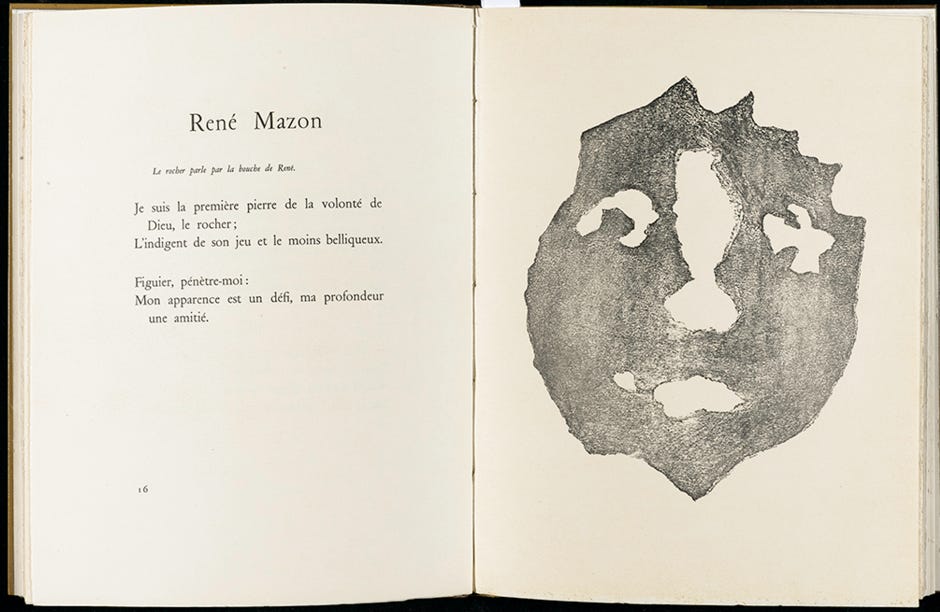Pablo Picasso, Grotesque (René Mazon), illustration in the book Les transparents by René Char (Alès: PAB [Pierre André Benoit]), 1967. Cardboard Cut Printed On Rives Wove Paper, 12 13/16 x 9 5/8 in. (32.5 x 24.5 cm). Fine Arts Museums of San Francisco, Gift of the Reva and David Logan Foundation, 2000.200.43.1–9. © 2022 Estate of Pablo Picasso/Artists Rights Society (ARS), New York.
Benoit Éditeur
Legion of Honor \ March 12 – August 28, 2022
SAN FRANCISCO—The atelier of the astonishingly prolific Pierre André Benoit (1921–1993) in Alès, France, turned out hundreds of fine-art editions with many of the most famous artists and poets of the 20th century. Fifteen of these stunning creations are presented at the Legion of Honor in Benoit Éditeur, featuring rarely seen titles that incorporate unconventional formats and materials in book design.
Benoit was a wildly creative designer of books, and the imprint “PAB” was his signature. Independently wealthy, Benoit had the freedom to produce work with little regard for financial return, working only with the poets and artists he admired. Benoit Éditeur presents thirteen illustrated books that Benoit produced with Pablo Picasso between 1957 and 1967, with most of the engravings made from celluloid plates. Benoit produced seventeen illustrated books in all with Picasso, demonstrating an uncanny ability to match art with literature. Both artists were prolific, valuing how a spontaneous approach to art making can capture emotion with immediacy and clarity of vision.
Picasso’s work with Benoit shows him to often be not merely an illustrator but an active collaborator in the books’ format and design. The collaborations began in 1956, with Picasso providing a celluloid engraving to accompany “Nuit,” a poem by René Crevel. Benoit Éditeur presents PAB books in unusual formats, including a binding with frog skins and a device for creating interactive poetry conceived by poet Tristan Tzara. There are also four miniatures, the tiniest of them being Température (1960), in which Picasso illustrates a short poem by his wife Jacqueline Roque in a format measuring less than an inch tall and barely an inch and a half wide. At the other end of the scale is VIIIe Pythique, Pindar’s Eighth Pythian Ode, a deluxe oversize volume. Benoit and Picasso’s final collaboration, in 1967, was one of their most striking, illustrating Les Transparents, a suite of poems by René Char. Picasso produced an unusual series of prints from torn cardboard, evoking the ghostly apparitions that appear in the poetry.
Benoit created books with many prominent French poets and writers, including Antonin Artaud, André Breton, Paul Claudel, René Crevel, Paul Éluard, and Michel Seuphor. Near the end of his life, he established a museum in Alès to house his art collection and the formidable archive of his publications.
The exhibition also includes two PAB books illustrated by artist Jesse Reichek (1916– 2005), who taught design at the University of California, Berkeley, from 1953 to 1986. His work was exhibited widely, most frequently at the Betty Parsons Gallery in New York. For Benoit, Reichek illustrated two poems by René Char, both published in 1961.
About Pierre André Benoit
Pierre André Benoit (French, 1921–1993) was born in Alès, France, and lived there throughout his life. The son of a prosperous insurer, he began his long career in 1942 with the publication of a previously unpublished text by French poet Paul Claudel. A breakthrough came several years later when the influential critic Michel Seuphor introduced Benoit to many of the most prominent artists and poets of the day, most of whom eventually contributed work to the press. Benoit established a museum in Alès in 1989 to house his art collection and the hundreds of fine-art publications produced under the PAB imprint.
About Jesse Reichek
Brooklyn-born Jesse Reichek (1916–2005) studied at the School of Design in Chicago, where he was an assistant to László Moholy-Nagy, and the Académie Julian in Paris. He taught at the University of California, Berkeley, as professor of design and city & regional planning from 1954 until 1986. He was internationally known in a parallel career as a painter, with eight solo exhibitions at the Betty Parsons Gallery in New York. “A mystical abstractionist in the line of Klee, Kandinsky, and Mondrian,” wrote journalist Jesse Hamlin, “[Reichek] made his name in New York and Paris in the 1950s and ’60s but withdrew from the art world and just painted, seeking a connection with some unknowable divine presence.”
legionofhonor.org \ @legionofhonor
Ticketing and Visiting
Benoit Éditeur is included in general admission to the Legion of Honor. More information regarding tickets can be found at legionofhonor.org.
About the Fine Arts Museums of San Francisco
The Fine Arts Museums of San Francisco oversee the de Young, located in Golden Gate Park, and the Legion of Honor, in Lincoln Park. It is the largest public arts institution in San Francisco, and one of the most visited arts institutions in the United States.
The Legion of Honor was modeled after the neoclassical Palais de la Légion d’Honneur in Paris. The museum, designed by George Applegarth, opened in 1924 on a bluff in Lincoln Park overlooking the Golden Gate. It offers unique insight into the art historical, political, and social movements of the previous 4,000 years of human history, with holdings including ancient art from the Mediterranean basin; European painting, sculpture, and decorative arts; and the largest collection of works on paper in the American West.
